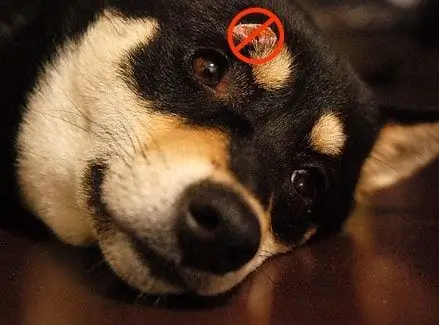
- Autor Daisy Haig [email protected].
- Public 2023-12-17 03:07.
- Última modificación 2025-01-24 12:36.
Mis dos bulldogs franceses han sufrido de tumores antiestéticos, a menudo con comezón y técnicamente benignos que llamamos histiocitomas. Aunque los histiocitomas generalmente se resuelven después de dos o tres meses, la incertidumbre de la procedencia de este tumor lleva a la mayoría de los veterinarios a cortarlo (o al menos parte de él) para asegurar su benignidad.
Un escalpelo quirúrgico de una masa “benigna” puede parecerle extremo, pero dado que los histiocitomas pueden ser molestos y atemorizantes, a menudo está indicada la cirugía.
Molesto: porque a menudo aparecen en la cabeza y los pies, lugares donde una masa perfectamente redonda y ulcerada se puede rascar o lamer fácilmente.
Aterrador: porque es difícil saber si lo que acaba de aparecer en la piel de su perro (y generalmente sucede rápido) es un tumor de mastocitos desagradable (o alguna otra masa monstruosa similar) … o su primo más tolerante, el histiocitoma.
Aterrador: porque es difícil saber si lo que acaba de aparecer en la piel de su perro (y generalmente sucede rápido) es un tumor de mastocitos desagradable (o alguna otra masa monstruosa similar) … o su primo más tolerante, el histiocitoma.
while young dogs (under three years of age) are more likely to get these, they can happen to dogs of any age. indeed, my older frenchie, sophie sue got one about a year ago. she was nine-not exactly a spring chicken. vincent has had three. and he’s not yet two years old.
some breeds are more predisposed. labrador retrievers and boxers, for example. though frenchies aren’t on the list, perhaps they should be… (perhaps they should be on the list for almost everything if my recent round of healthcare scares is any guide.)
ugly and prominently placed as they typically are, most owners want histiocytomas removed. some vets, however, will counsel owners to either wait a few weeks (especially if the dog is young and statistically less likely to be suffering from a malignant mass) or to have a simple section of it snipped (with a local anesthetic) for histopathological analysis at the pathology lab.
other vets will even take a needle poke at it, though most pathologists find that histiocytomas are not easily disgnosed definitively through this method (cytology).
if the dog is older or the mass is especially annoying to the dog or owner, however, we remove the whole sucker and clean up the mess quickly. unfortunately, though, this approach is more costly and usually requires general anesthesia. it’s nonetheless the approach i take for more than half of these tumors…better to be safe than sorry, right?
still, most owners need to know they have a choice. the nervous nellies among you (like me) are less likely to want to stare at a mass for a couple of months to see if it simply goes away. the rational or more anesthetically cautious, however, are justified in waiting-as long as their dog is young and/or hasn’t suffered from malignant masses in the past.
whatever choice you make, consider histiocytomas an excellent foray into the world of skin tumors. it’s like a warm-up for what’s likely to come as your dog ages. and it’s not all bad. look on the bright side: curing cancer is sometimes just a scalpel slice away.
Recomendado:
El Gato Gordito De Polidactilo Que Busca Un Hogar Se Convierte En Una Sensación Viral

Un gato polidactilo está causando sensación en Internet con su peculiar personalidad y su lista de demandas muy específicas
Eagle Webcam Se Convierte En Una Sensación De Internet

WASHINGTON - Las cámaras instaladas en lo alto de un árbol en Iowa han causado sensación en Internet de una familia de águilas calvas, cuyo nido se transmite en línea en vivo día y noche. "Por qué viral, no estoy muy seguro", dijo Bob Anderson, director del Raptor Resource Project, sobre el éxito de la cámara web Eagle. "
Los 'cielos Amistosos' No Son Tan Amigables Para Las Mascotas

La gente parece volar por menos dinero que nunca en estos días. Y aunque es posible que se le cobre un extra por un refrigerio, una bebida o el registro de equipaje en su vuelo (se han hecho conversaciones para cobrar incluso por usar las instalaciones sanitarias), al menos es posible hacer una escapada rápida y barata. D
Reducción De La Ansiedad En La Clínica Veterinaria: Veterinarios Sin Miedo, Con Poco Estrés Y Amigables Con Los Gatos

¿Has visto alguna vez a una mascota a la que le guste ir a la clínica veterinaria? Descubra cómo algunos veterinarios están buscando nuevas certificaciones que ayudarán a reducir el estrés de su mascota en la clínica veterinaria
Cortar, Cortar En Cubitos Y Biopsiar El Histiocitoma Benigno

Dos de mis últimos cuatro perros han sufrido de tumores cutáneos antiestéticos y técnicamente benignos que llamamos histiocitomas. Aunque los histiocitomas generalmente se resuelven después de dos o tres meses (o menos), la incertidumbre de la procedencia de este tumor lleva a la mayoría de los veterinarios a cortarlo (o al menos parte de él) para que todos puedan dormir tranquilos por la noche sabiendo que ningún mal acecha sin tratar. La
